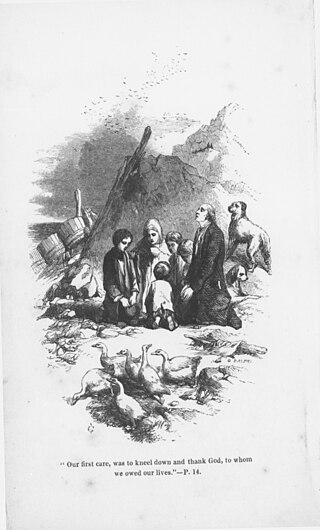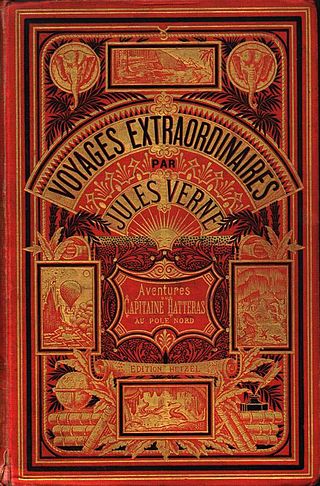
Jules Gabriel Verne was a French novelist, poet, and playwright. His collaboration with the publisher Pierre-Jules Hetzel led to the creation of the Voyages extraordinaires, a series of bestselling adventure novels including Journey to the Center of the Earth (1864), Twenty Thousand Leagues Under the Seas (1870), and Around the World in Eighty Days (1872). His novels, always well documented, are generally set in the second half of the 19th century, taking into account the technological advances of the time.

Twenty Thousand Leagues Under the Seas is a classic science fiction adventure novel by French writer Jules Verne.

Captain Nemo is a character created by the French novelist Jules Verne (1828–1905). Nemo appears in two of Verne's science-fiction books, Twenty Thousand Leagues Under the Seas (1870) and The Mysterious Island (1875). He also makes a brief appearance in a play written by Verne with the collaboration of Adolphe d'Ennery, Journey Through the Impossible (1882).

Johann David Wyss was a Swiss author, best remembered for his book The Swiss Family Robinson (1812). He was born and died in Bern. It is said that he was inspired by Daniel Defoe's Robinson Crusoe, but wanted to write a story from which his own children would learn, as the father in the story taught important lessons to his children. The Swiss Family Robinson was first published in German in 1812, then translated into English two years later. It has since become one of the most popular books of all time. The book was edited by his son, Johann Rudolf Wyss, a scholar known for writing the Swiss national anthem, Rufst du, mein Vaterland. Another of Wyss's sons, Johann Emmanuel Wyss, illustrated the book. Johann David Wyss died in 1818 at the age of 74. He lived longer than his son Johann Rudolf, who would die twelve years later at the age of 48.

The Swiss Family Robinson is a novel by the Swiss author Johann David Wyss, first published in 1812, about a Swiss family of immigrants whose ship en route to Port Jackson, Australia, goes off course and is shipwrecked in the East Indies. The ship's crew is lost, but the family and several domestic animals survive. They make their way to shore, where they build a settlement, undergoing several adventures before being rescued; some refuse rescue and remain on the island.

Friday is one of the main characters of Daniel Defoe's 1719 novel Robinson Crusoe and its sequel The Farther Adventures of Robinson Crusoe. Robinson Crusoe names the man Friday, with whom he cannot at first communicate, because they first meet on that day. The character is the source of the expression "Man Friday", used to describe a male personal assistant or servant, especially one who is particularly competent or loyal.

The Mysterious Island is a novel by Jules Verne, published in 1875. The first edition, published by Hetzel, contains illustrations by Jules Férat. The novel is a crossover sequel to Verne's famous Twenty Thousand Leagues Under the Seas (1870) and In Search of the Castaways (1867–68), though its themes are vastly different from those books. An early draft of the novel, rejected by Verne's publisher and wholly reconceived before publication, was titled Shipwrecked Family: Marooned with Uncle Robinson, indicating the influence of the novels Robinson Crusoe and The Swiss Family Robinson. Verne developed a similar theme in his novel, Godfrey Morgan.

The Voyages extraordinaires is a collection or sequence of novels and short stories by the French writer Jules Verne.

In Search of the Castaways is a novel by the French writer Jules Verne, published in 1867–68. The original edition, published by Hetzel, contains a number of illustrations by Édouard Riou. In 1876, it was republished by George Routledge & Sons as a three volume set titled A Voyage Round The World. The three volumes were subtitled South America, Australia, and New Zealand. As often with Verne, English translations have appeared under different names; another edition has the overall title Captain Grant's Children and has two volumes subtitled The Mysterious Document and Among the Cannibals.

Robinsonade is a literary genre of fiction wherein the protagonist is suddenly separated from civilization, usually by being shipwrecked or marooned on a secluded and uninhabited island, and must improvise the means of their survival from the limited resources at hand. The genre takes its name from the 1719 novel Robinson Crusoe by Daniel Defoe. The success of this novel spawned so many imitations that its name was used to define a genre, which is sometimes described simply as a "desert island story" or a "castaway narrative".

Adventure fiction is a type of fiction that usually presents danger, or gives the reader a sense of excitement. Some adventure fiction also satisfies the literary definition of romance fiction.

A castaway is a person who is cast adrift or ashore. While the situation usually happens after a shipwreck, some people voluntarily stay behind on a desert island, either to evade captors or the world in general. A person may also be left ashore as punishment (marooned).

Off on a Comet is an 1877 science fiction novel by French writer Jules Verne. It recounts the journey of several people carried away by a comet contacting the Earth. The comet passes by various bodies in the Solar System before returning the travelers to the Earth.

Two Years' Vacation is an adventure novel by Jules Verne, published in 1888. The story tells of the fortunes of a group of schoolboys stranded on a deserted island in the South Pacific, and of their struggles to overcome adversity. In his preface to the book, Verne explains that his goals were to create a Robinson Crusoe-like environment for children, and to show the world what the intelligence and bravery of a child were capable of when put to the test.

Swiss Family Robinson is a 1940 American film released by RKO Radio Pictures and directed by Edward Ludwig. It is based on the 1812 novel The Swiss Family Robinson by Johann David Wyss and is the first feature-length film version of the story.

Mysterious Island is a 1961 science fiction adventure film about prisoners in the American Civil War who escape in a balloon and then find themselves stranded on a remote island populated by giant and tiny animals.

Propeller Island is a science fiction novel by French author Jules Verne (1828–1905). It was first published in 1895 as part of the Voyages Extraordinaires. It relates the adventures of a French string quartet in Milliard City, a city on a massive ship in the Pacific Ocean, inhabited entirely by millionaires.

The Kip Brothers is an adventure novel written by Jules Verne, one of his Voyages extraordinaires. Karl and Pieter Kip are rescued after being castaways on an island in the South Seas. They help to put down a mutiny on the brig but are then accused of murdering the captain.

Godfrey Morgan: A Californian Mystery, also published as School for Crusoes, is an 1882 adventure novel by French writer Jules Verne. The novel tells of a wealthy young man, Godfrey Morgan, who, with his deportment instructor, Professor T. Artelett, embark from San Francisco, California, on a round-the-world ocean voyage. They are cast away on an uninhabited Pacific island, where they must endure a series of adversities. Later, they encounter an African slave, Carefinotu, brought to the island by cannibals. In the end, the trio manage to work together and survive on the island.

The Golden Volcano is a novel by Jules Verne, edited by his son Michel Verne, and published posthumously in 1906.





















